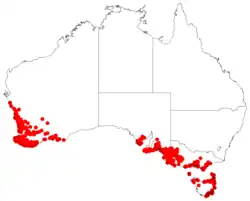Comesperma calymega
| Comesperma calymega | |
|---|---|

| |
| Scientific classification | |
| Kingdom: | Plantae |
| Clade: | Tracheophytes |
| Clade: | Angiosperms |
| Clade: | Eudicots |
| Clade: | Rosids |
| Order: | Fabales |
| Family: | Polygalaceae |
| Genus: | Comesperma |
| Species: | C. calymega
|
| Binomial name | |
| Comesperma calymega | |

| |
| Occurrence data from AVH | |
| Synonyms[2] | |
|
Bredemeyera calymega (Labill.) Chodat | |
Comesperma calymega, commonly known as blue-spike milkwort, is a slender herb in the family Polygalaceae.[3] It is a perennial herb growing to between 10 cm and 50 cm high,[3] from a short woody rhizome.[4]
The species was first formally described by French botanist Jacques Labillardière in Novae Hollandiae Plantarum Specimen in 1806, from a specimen collected in Tasmania.[1][5]
The species occurs in the states of South Australia, Tasmania, Victoria, and Western Australia.[2]
References
- ^ a b "Comespermum calymega". Australian Plant Name Index, IBIS database. Centre for Plant Biodiversity Research, Australian Government.
- ^ a b "Comesperma calymega Labill. | Plants of the World Online | Kew Science". Plants of the World Online. Retrieved 2021-01-03.
- ^ a b "Comesperma calymega". FloraBase. Western Australian Government Department of Biodiversity, Conservation and Attractions.
- ^ "Flora of Victoria: Comesperma calymega". vicflora.rbg.vic.gov.au. Archived from the original on 2017-08-31. Retrieved 2021-01-03.
- ^ Labillardiere, J.J.H. de (1806). "Diadelphia octandria". Novae Hollandiae Plantarum Specimen. 2 (17): 23, t. 162.